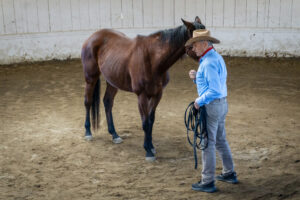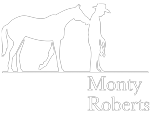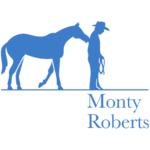
We have three seconds in which to express contentment or discontent with the actions of our horses.— Monty Roberts
Horsemanship Clinics are flourishing and there has never been a time in history when horse owners have had more opportunity to learn to be better owners of their horses. So why are so many of us confused at times by the multitude of opinions and seemingly opposing answers about horsemanship?
With horses, in the beginning of their training we cannot explain to them what we would like them to do, in spoken English. Instead, causing a thousand pound horse to do anything is a process called training. There are many different methods.
It is said, “A good trainer can get a horse to do almost anything, but the great trainer can get the horse to want to do it.”
For example ,when training a horse to stand still on command, you’ll find that a key part of the process involves a lot of backing up. Why? Because backing up isn’t natural for a horse—it requires more effort and focus than simply standing still or moving forward. It’s something they don’t instinctively want to do, which makes it an effective tool for teaching them how to listen and respond to your cues.
In this process, trust plays a major role. Your horse needs to trust that you are guiding them safely and with purpose, especially when it feels like you’re asking them to do something unnatural. For the horse, backing up takes more physical and mental energy than moving forward or standing still. And that’s why it’s so important—it builds the foundation for the behavior you want: standing still.
Here’s the progression: Every time your horse tries to move off when you’ve asked them to stand, you will gently ask them to back up instead. Over time, they’ll begin to understand that standing still is the response you’re looking for. Once they consistently respond to your request, you can drop the reins and see if they’ve figured it out.
The goal is to make standing still the natural, desired outcome. When you drop the reins and your horse remains calm and still, you’ll know they’ve made the connection and trust you enough to follow your cue.
In essence, this process isn’t just about teaching your horse to stand still—it’s about building a relationship based on trust, communication, and mutual understanding. It’s a bit more work, but the result is a horse that listens and responds with patience and respect.
This is where some trainers miss the point of reinforcing a desired behavior by only professing Positive Reinforcement. On the surface, Positive Reinforcement sounds good and Negative Reinforcement sounds bad. Scientifically, this is not true. What we really want to do is “reinforce” the desired behavior (standing still) without punishing the horse. Some people incorrectly think Negative Reinforcement means pain and punishment.
Punishment is an attempt to influence the horse’s behavior by adding something painful, which can eventually lead to mistrust and other dangerous behaviors by your horse.
In contrast, negative reinforcement is an attempt to influence the desired behavior of standing still by a cessation of work done by the horse, like the backing up. Training your horse to ‘think for himself,’ rather than being compliant because of punishment, creates a better relationship with your horse.
My favorite example is a horse who used to be dangerous unloading from the trailer. When we dropped the gate, he would blow backwards down the ramp and anyone nearby could hear the hooves pounding and knew you were home. It took a long time but the repetition of loading him back on and asking for a slow retreat before heading to his stall, eventually taught him how to safely unload.
We knew he was finally trained and safe when we came home from a trip and went to unload. He forgot for a moment and unloaded a little faster than we had trained him to by slowly and carefully backing out. Knowing our routine, he took a breath and loaded himself up again, only to unload like a gentleman, all on his own.
Creating a great relationship and a happy horse can be one of the most enjoyable things a horse lover can do. It takes patience and an understanding of the flight animal. If you are willing to be a student of your horse’s behavior, you will have a horse who enjoys being with you and understands your needs too.
— Monty Roberts
Monty Roberts, known worldwide as the Horse Whisperer, has spent decades perfecting the art of building trust and understanding between humans and horses. His revolutionary techniques have transformed the way we approach horse training, creating deeper, more respectful relationships based on communication and empathy.
Sign up for a course to deepen your horsemanship skills, at
https://montyroberts.com/learning-center/calendar/
or purchase the book “From Our Hands to Yours” to learn Monty’s life-changing approach to training and building trust with your horse.
Don’t miss the chance to train the way Monty Roberts has taught thousands of horse lovers worldwide. Start your journey today!

